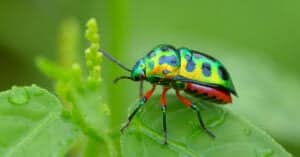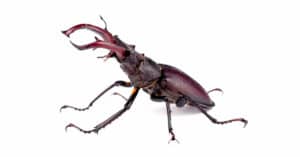Beetles are intriguing insects that come in many shapes and sizes. These characteristics are also the easiest way to distinguish the critters, aside from location. With over 350,000 species of beetles in their phylogenetic order, Coleoptera, there are more types of these creatures than any other. Yet, knowing about different types of black beetles along with their location in the world can help people identify some of the more common genera of beetles.
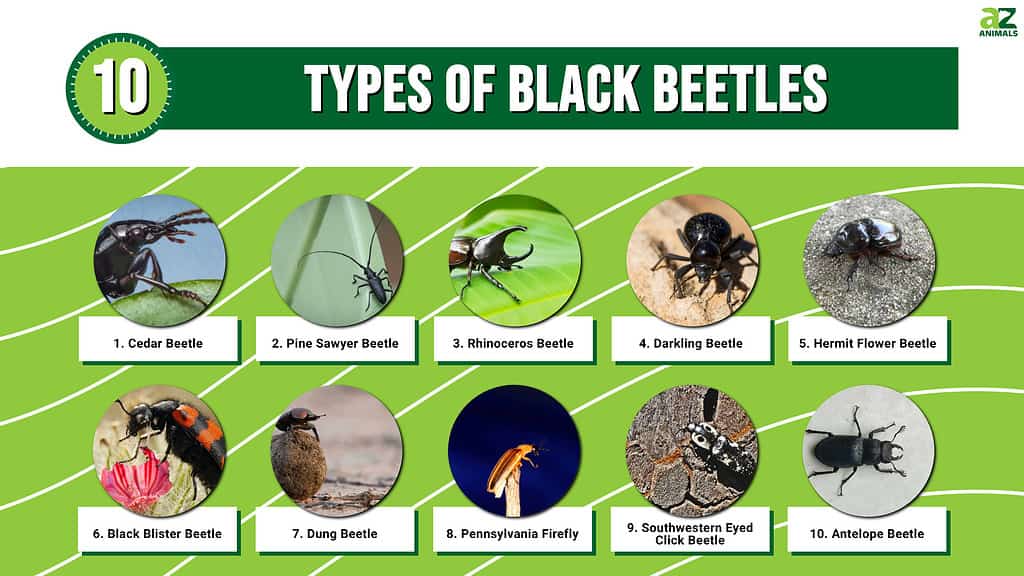
Uncover 10 different types of black beetles and find out how big they get and what makes them unique!
1. Cedar Beetle

Cedar beetles hunt cicada grubs or nymphs by searching the ground for them.
©Ezume Images/Shutterstock.com
The cedar beetle is from the species Sandalus niger, and they are unlike many other similar critters. Their alternative name is the cicada parasite beetle, and they hunt cicada grubs or nymphs by searching the ground. These creatures have dark brown wings but a black head featuring a unique comb-like antenna. Also, they grow about 1 inch in total body length.
2. Pine Sawyer Beetle

Pine sawyer beetles generally reach between 1.5 and 2.5 inches long.
©valleyboi63/Shutterstock.com
The pine sawyer beetle (Ergates spiculatus) is one of the largest types of black beetles on this list. This creature can measure between 1.5 and 2.5 inches long! The critter lives in the western part of the United States. They have long bodies and very long antennae as well. They’re one of the largest species of wood-boring beetles.
3. Rhinoceros Beetle

Particularly strong, some
rhinoceros
beetle species can lift up to 850 times their weight.
©iStock.com/rawintanpin
Rhinoceros beetles are members of the Dynastinae genus, and they’re some most powerful beetles around. Some species lift upwards of 850 times their weight. They can measure between 0.8 and 1.3 inches long on average, but many species exist. Still, a few species can be found throughout large swaths of North America. They’re known for their spiny legs and large protrusions on heads, at least in the case of males.
4. Darkling Beetle
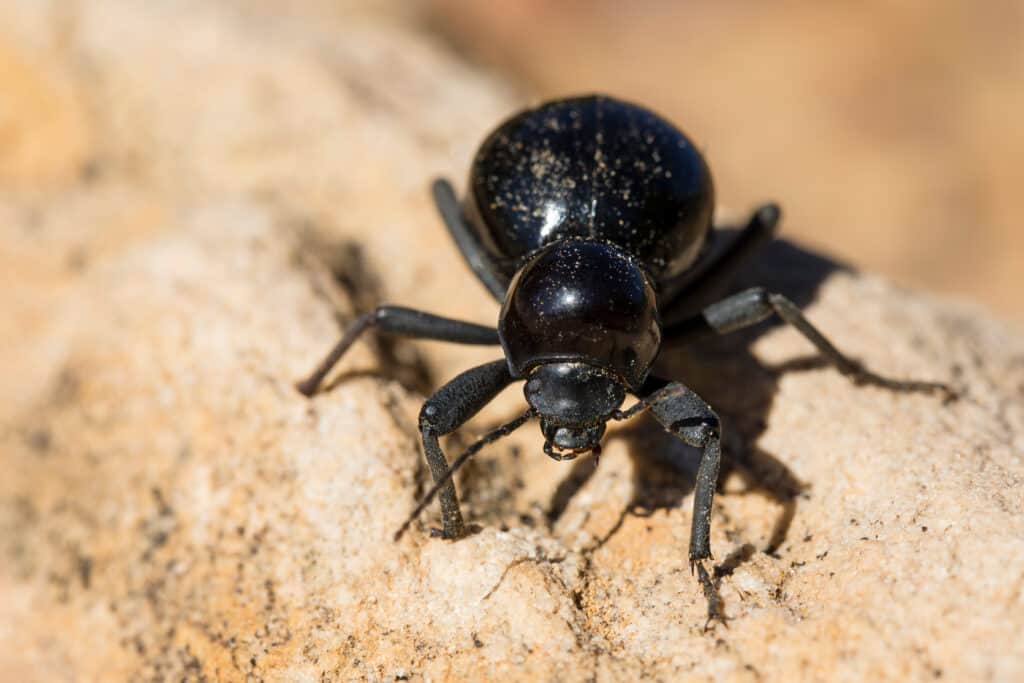
Darkling beetles are rather small, under an inch long on average.
©Therina Groenwald/Shutterstock.com
The darkling beetle comes from a very large family of beetles called Tenebrionidae. Over 20,000 critters belong to this family. These insects are usually completely black, and they grow to about three-quarters of an inch long at their largest. The insects do not fly, though. They can be seen feeding on fungi, carrion, and sometimes dung depending on the species. At least one species from this family can be found in every part of North America.
5. Hermit Flower Beetle
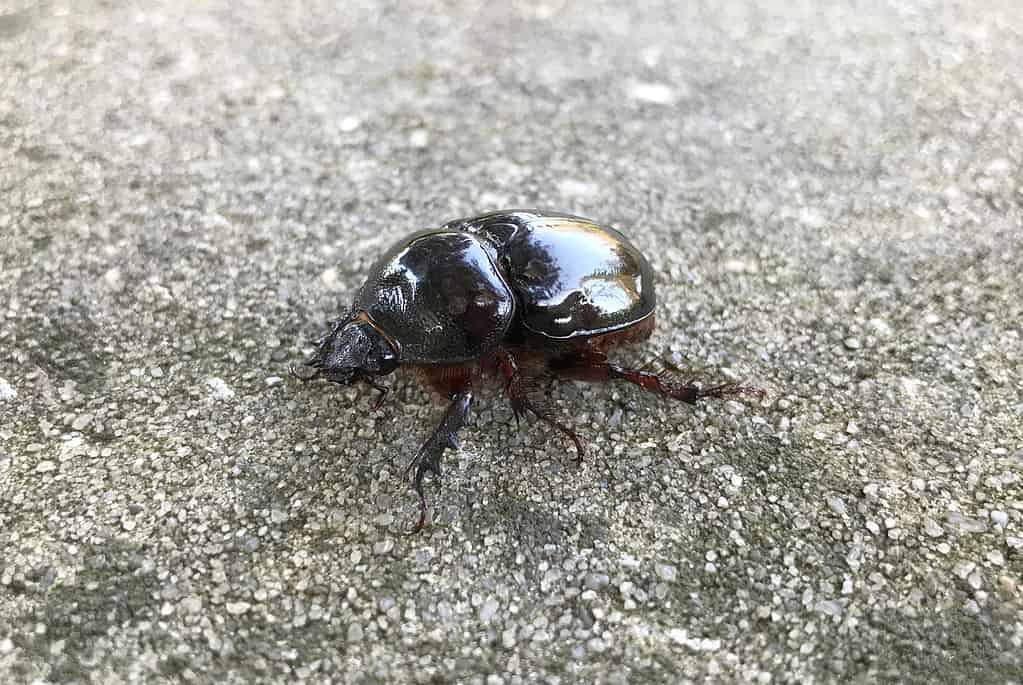
Hermit flower beetles are shy, most of the time trying to stay out of the way.
©Richard Velayo/Shutterstock.com
The hermit flower beetle tries to stay out of the way. So, they’re not too easy to find. In fact, humans that disturb them are more likely to smell the odor from Osmoderma eremicola before they see them. Still, they’re large, shiny, and dark brown or black beetles that live throughout most of North America. Oftentimes, they will grow between 1 and 1.2 inches long.
6. Black Blister Beetle
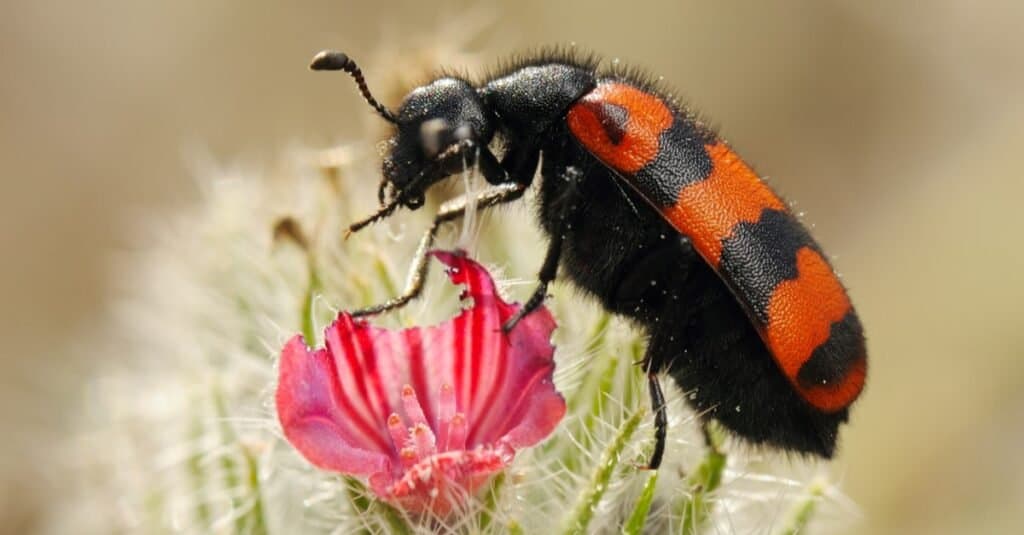
Blister beetles aren’t large, but they are harmful. They secrete a harmful chemical when threatened, causing irritation and potentially blisters if contact is made with human skin.
©vblinov/Shutterstock.com
The black blister beetle (Epicauta pennsylvanica) is one of the few types of beetles on this list that can actually hurt people! These black beetles are not very large, only measuring between 0.2 and 0.7 inches long. These critters are widespread throughout North America, and they’re known for secreting harmful chemicals when they feel threatened. If that chemical gets on a human’s skin, it can cause irritation or even a blister. While they are often black, blister beetles can also exhibit other colors, like yellow. It’s best to leave these insects alone rather than risk a painful blister.
7. Dung Beetle
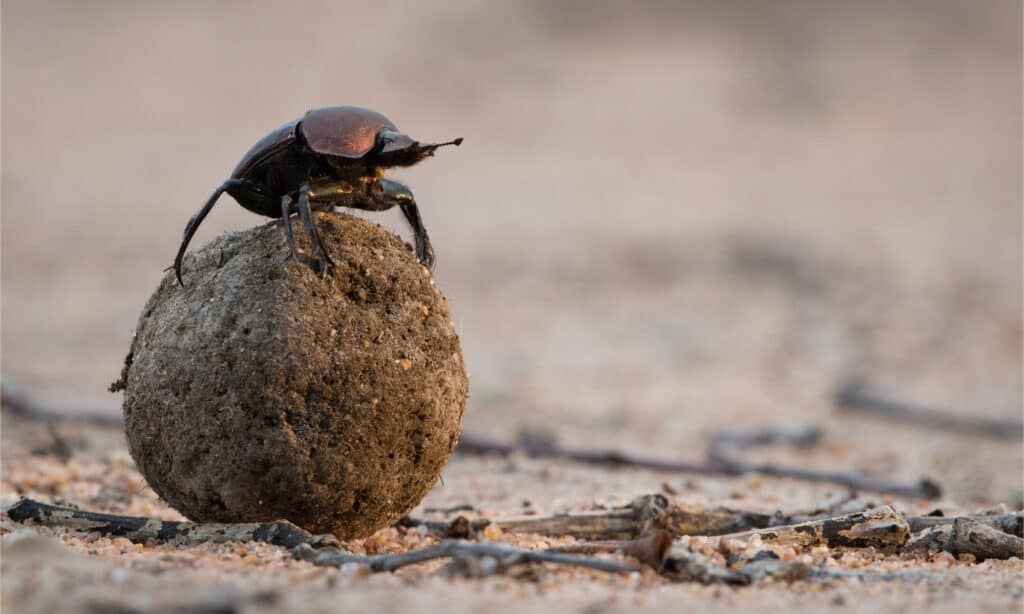
Given that they eat dung, roll dung balls, and lay their eggs in those balls, dung beetles make their lives with dung.
©Villiers Steyn/Shutterstock.com
Dung beetles are scarabs that spend a lot of their lives interacting with dung. They consume nutrients from dung, lay their eggs in the dung balls they roll, and engage in other dung-oriented activities. These black beetles can measure anywhere from 0.75 to 1.2 inches in length, and they’re found throughout North America. They’re not harmful to humans, and they serve an important role in transporting dung in some parts of the world.
8. Pennsylvania Firefly
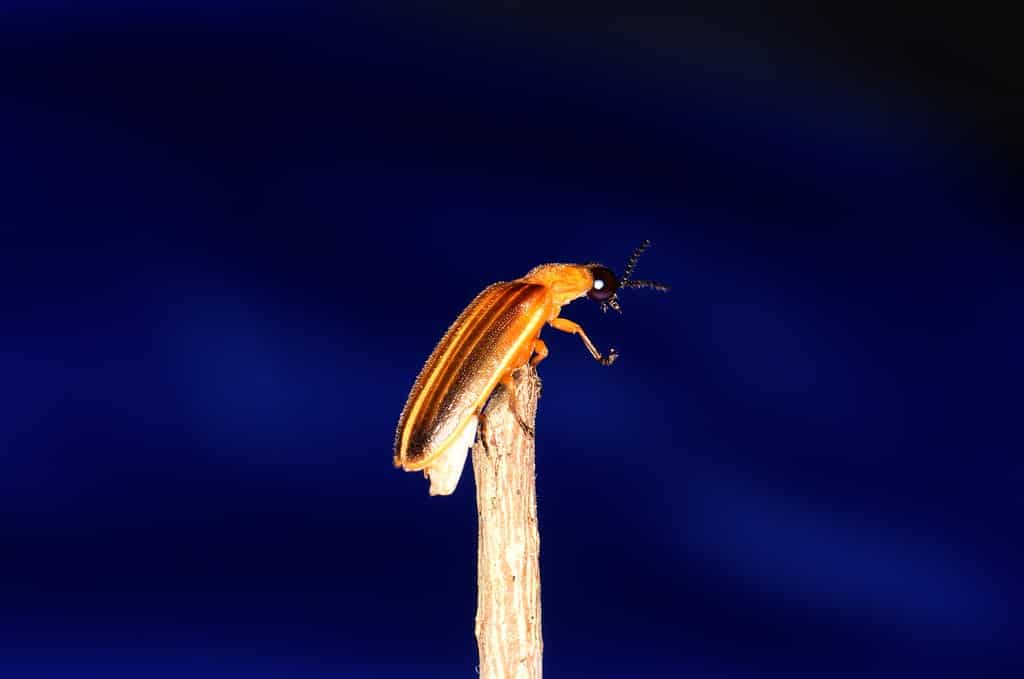
Pennsylvania fireflies’ black and yellow wings help distinguish them from other black beetles.
©glebantiy/Shutterstock.com
The Pennsylvania firefly is one of the most recognizable types of beetle in North America. They are known for their long antennae along with their black and yellow wings that somewhat resemble a sunflower seed. Of course, there’s also the fact that they can emit a light signal to find mates.
Bioluminescence is very rare, especially as a trait in beetles. Typically, the fireflies will only take part in this effort during the summertime breeding season. Even then, they only try to find mates during dry nights.
9. Southwestern Eyed Click Beetle
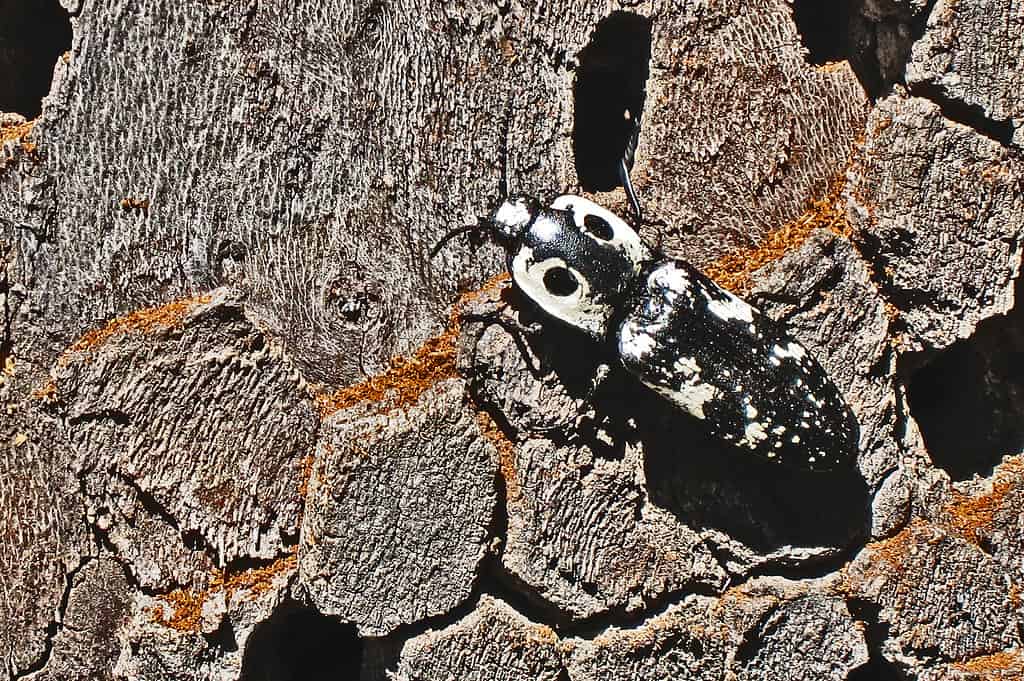
Eyed click beetles have a striking black-and-white color scheme.
©Joseph C Boone/Wikimedia Commons – License
The southwestern-eyed click beetle is one of the most distinct types of black beetle. Alaus zunianus is a very long beetle that measures from 1 to 2 inches long. The insect is known for having a speckled pattern of white and black on its body. Moreover, the beetle’s pronotum has two white and black spots on it that resemble eyes. As a result, the beetle can look a little intimidating at first glance.
Still, they won’t hurt a person other than by annoying them with the clicking noise they make when flipping their bodies. They can be troublesome for crops, though.
10. Antelope Beetle
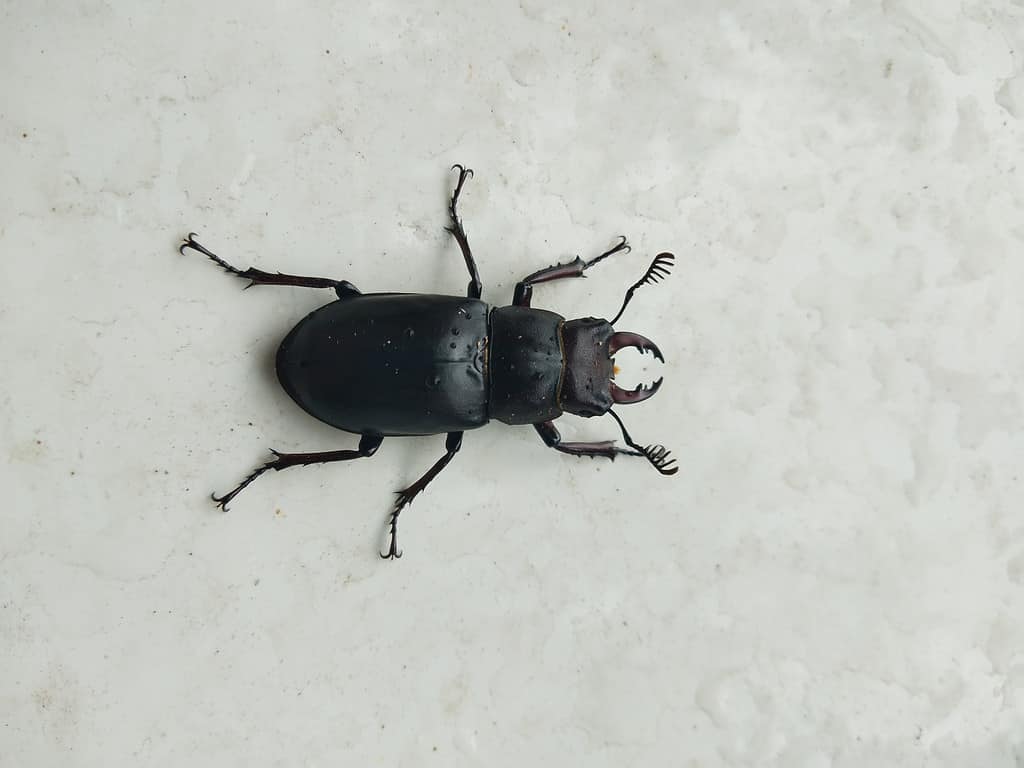
Measuring up to about an inch long,
antelope
beetles are quite large.
©Studio Caramel/Shutterstock.com
The antelope beetle is a fairly large type of black beetle that measures up to an inch long. These insects belong to the stag beetle family. They have rectangular bodies and large heads. Furthermore, they’re known for having pincers on its head. As a result, they can bite people. They’re not overly dangerous to people, but the experience can still be unpleasant.
These 10 types of black beetles are different in many respects. They range in size, looks, and the ability to cause harm. Knowing the color of a beetle is a useful first step in determining which genus or species a person is looking at.
Summary of 10 Types of Black Beetles
| # | Beetle | Fun Fact |
|---|---|---|
| 1 | Cedar Beetle | They have a unique comb-like antennae |
| 2 | Pine Sawyer Beetle | They have unique comb-like antennae |
| 3 | Rhinoceros Beetle | Can lift up to 850 times their weight |
| 4 | Darkling Beetle | Eat fungi, carrion, and sometimes dung |
| 5 | Hermit Flower Beetle | These beetles are shy and stinky |
| 6 | Black Blister Beetle | Secrete a harmful substance that causes blistering when threatened |
| 7 | Dung Beetle | They roll dung into balls |
| 8 | Pennsylvania Firefly | They are Bioluminescent |
| 9 | Southwestern Eyed Click Beetle | Has a speckled black and white body |
| 10 | Antelope Beetle | These large beetles have a painful bite |
The photo featured at the top of this post is © 3,000 × 2,000 pixels, file size: 2.09 MB, MIME type: image/jpeg – License / Original
Thank you for reading! Have some feedback for us? Contact the AZ Animals editorial team.



